Strategic Financial Management: AYR Co Project Analysis Report
VerifiedAdded on 2021/12/22
|15
|4138
|97
Report
AI Summary
This report analyzes two investment proposals, Project Aspire and Project Wolf, for AYR Co to enhance market share and maximize shareholder wealth. It applies capital budgeting techniques like Net Present Value (NPV), Internal Rate of Return (IRR), and Payback Period to evaluate the projects, considering initial outlays, incremental cash flows, and salvage values. The analysis includes detailed calculations and a comparison of the two projects based on quantitative and qualitative factors, such as project scope, risk management, and competitor activity. The report also considers the role of financing, costs, and stakeholder impact associated with debt and equity, and concludes with a recommendation for the superior project based on the evaluation criteria. The report emphasizes that the decision-making should not solely rely on quantitative analysis but also considers selected qualitative parameters.
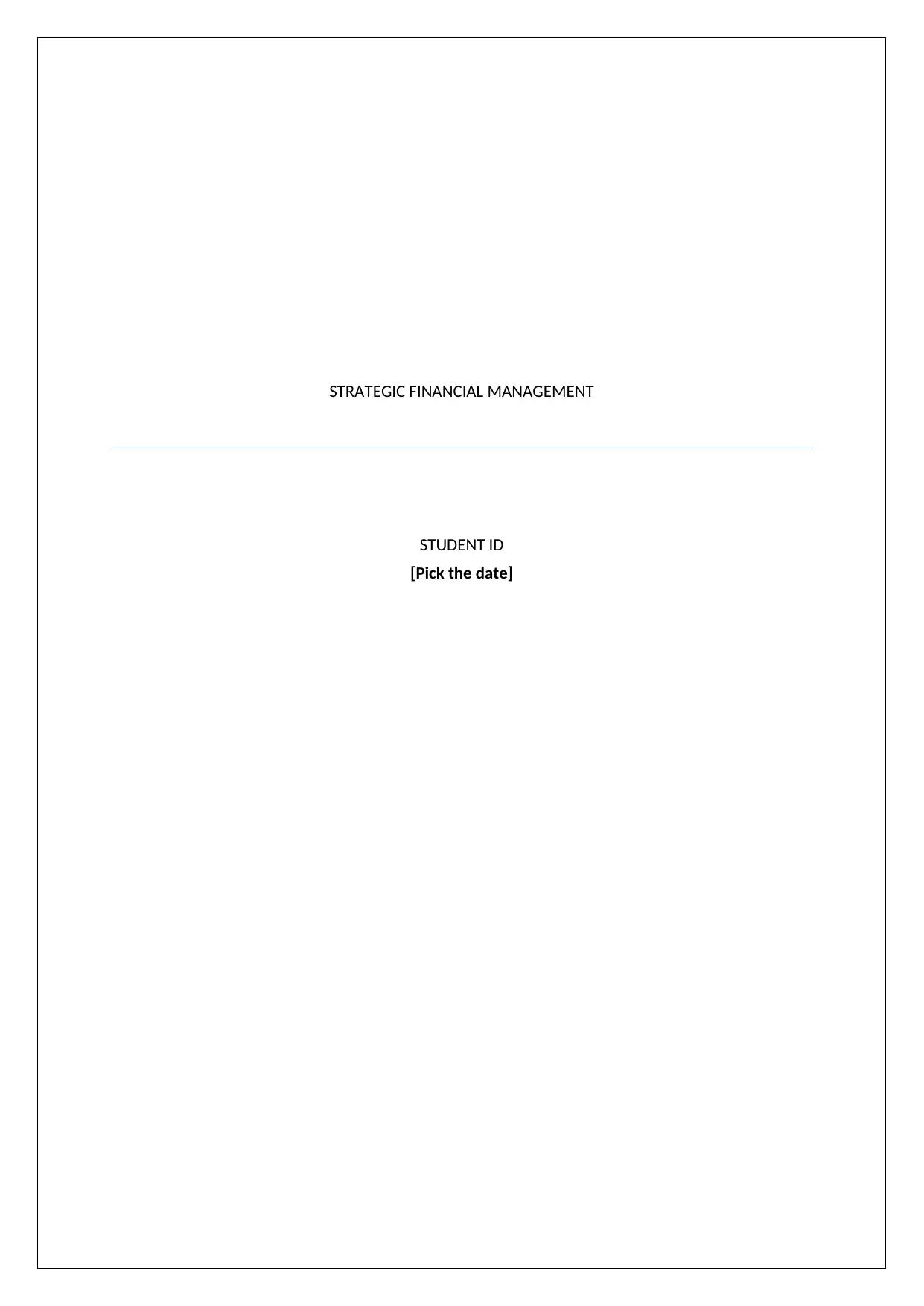
STRATEGIC FINANCIAL MANAGEMENT
STUDENT ID
[Pick the date]
STUDENT ID
[Pick the date]
Paraphrase This Document
Need a fresh take? Get an instant paraphrase of this document with our AI Paraphraser

TABLE OF CONTENTS
Introduction................................................................................................................................2
Application of Capital Budgeting Techniques...........................................................................2
Project Aspire.........................................................................................................................2
Project Wolf............................................................................................................................4
Analysis and Evaluation.............................................................................................................5
Sources of Finance.....................................................................................................................8
Conclusion................................................................................................................................10
REFERENCES.........................................................................................................................11
APPENDIX 1...........................................................................................................................13
1
Introduction................................................................................................................................2
Application of Capital Budgeting Techniques...........................................................................2
Project Aspire.........................................................................................................................2
Project Wolf............................................................................................................................4
Analysis and Evaluation.............................................................................................................5
Sources of Finance.....................................................................................................................8
Conclusion................................................................................................................................10
REFERENCES.........................................................................................................................11
APPENDIX 1...........................................................................................................................13
1
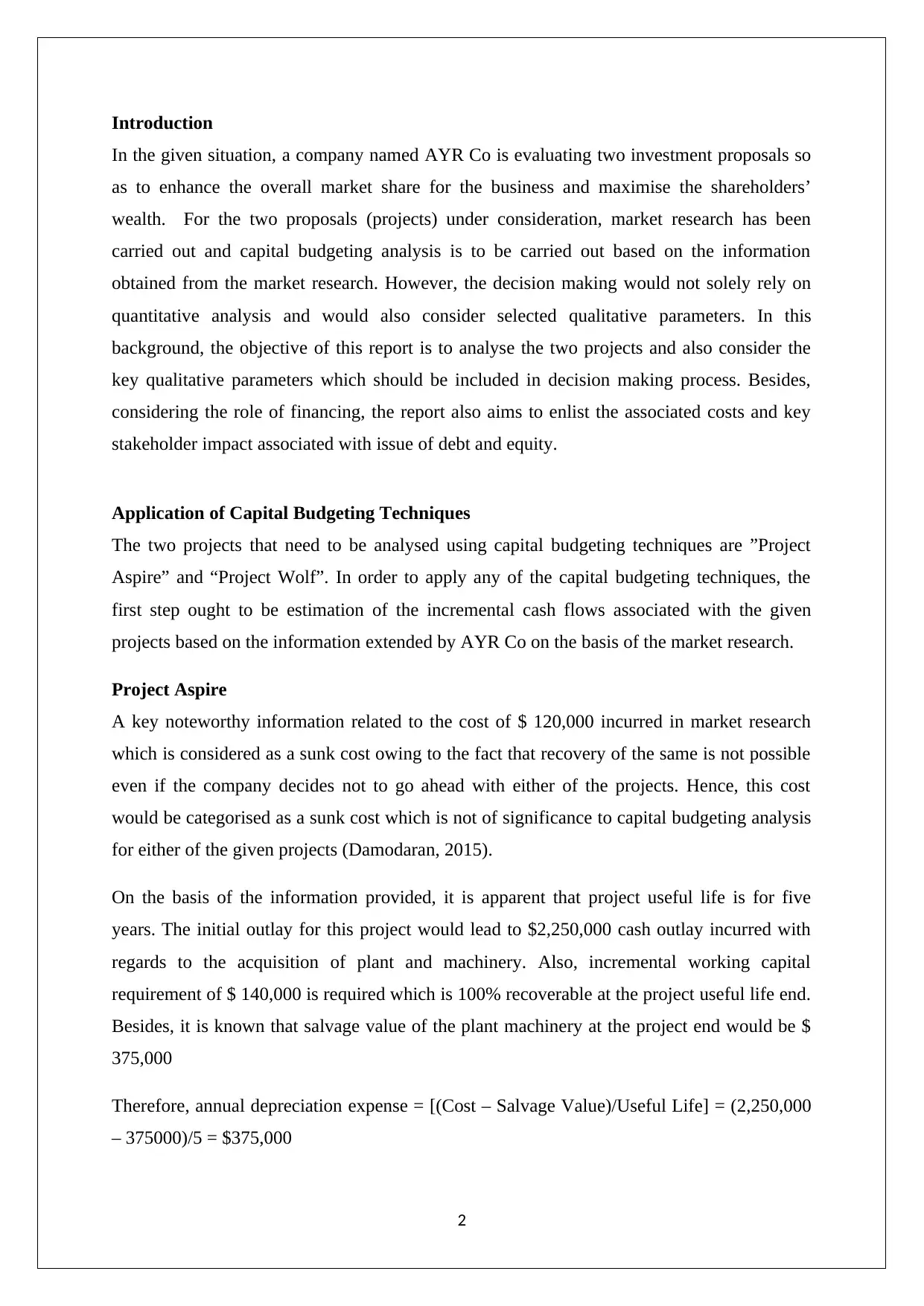
Introduction
In the given situation, a company named AYR Co is evaluating two investment proposals so
as to enhance the overall market share for the business and maximise the shareholders’
wealth. For the two proposals (projects) under consideration, market research has been
carried out and capital budgeting analysis is to be carried out based on the information
obtained from the market research. However, the decision making would not solely rely on
quantitative analysis and would also consider selected qualitative parameters. In this
background, the objective of this report is to analyse the two projects and also consider the
key qualitative parameters which should be included in decision making process. Besides,
considering the role of financing, the report also aims to enlist the associated costs and key
stakeholder impact associated with issue of debt and equity.
Application of Capital Budgeting Techniques
The two projects that need to be analysed using capital budgeting techniques are ”Project
Aspire” and “Project Wolf”. In order to apply any of the capital budgeting techniques, the
first step ought to be estimation of the incremental cash flows associated with the given
projects based on the information extended by AYR Co on the basis of the market research.
Project Aspire
A key noteworthy information related to the cost of $ 120,000 incurred in market research
which is considered as a sunk cost owing to the fact that recovery of the same is not possible
even if the company decides not to go ahead with either of the projects. Hence, this cost
would be categorised as a sunk cost which is not of significance to capital budgeting analysis
for either of the given projects (Damodaran, 2015).
On the basis of the information provided, it is apparent that project useful life is for five
years. The initial outlay for this project would lead to $2,250,000 cash outlay incurred with
regards to the acquisition of plant and machinery. Also, incremental working capital
requirement of $ 140,000 is required which is 100% recoverable at the project useful life end.
Besides, it is known that salvage value of the plant machinery at the project end would be $
375,000
Therefore, annual depreciation expense = [(Cost – Salvage Value)/Useful Life] = (2,250,000
– 375000)/5 = $375,000
2
In the given situation, a company named AYR Co is evaluating two investment proposals so
as to enhance the overall market share for the business and maximise the shareholders’
wealth. For the two proposals (projects) under consideration, market research has been
carried out and capital budgeting analysis is to be carried out based on the information
obtained from the market research. However, the decision making would not solely rely on
quantitative analysis and would also consider selected qualitative parameters. In this
background, the objective of this report is to analyse the two projects and also consider the
key qualitative parameters which should be included in decision making process. Besides,
considering the role of financing, the report also aims to enlist the associated costs and key
stakeholder impact associated with issue of debt and equity.
Application of Capital Budgeting Techniques
The two projects that need to be analysed using capital budgeting techniques are ”Project
Aspire” and “Project Wolf”. In order to apply any of the capital budgeting techniques, the
first step ought to be estimation of the incremental cash flows associated with the given
projects based on the information extended by AYR Co on the basis of the market research.
Project Aspire
A key noteworthy information related to the cost of $ 120,000 incurred in market research
which is considered as a sunk cost owing to the fact that recovery of the same is not possible
even if the company decides not to go ahead with either of the projects. Hence, this cost
would be categorised as a sunk cost which is not of significance to capital budgeting analysis
for either of the given projects (Damodaran, 2015).
On the basis of the information provided, it is apparent that project useful life is for five
years. The initial outlay for this project would lead to $2,250,000 cash outlay incurred with
regards to the acquisition of plant and machinery. Also, incremental working capital
requirement of $ 140,000 is required which is 100% recoverable at the project useful life end.
Besides, it is known that salvage value of the plant machinery at the project end would be $
375,000
Therefore, annual depreciation expense = [(Cost – Salvage Value)/Useful Life] = (2,250,000
– 375000)/5 = $375,000
2
⊘ This is a preview!⊘
Do you want full access?
Subscribe today to unlock all pages.

Trusted by 1+ million students worldwide
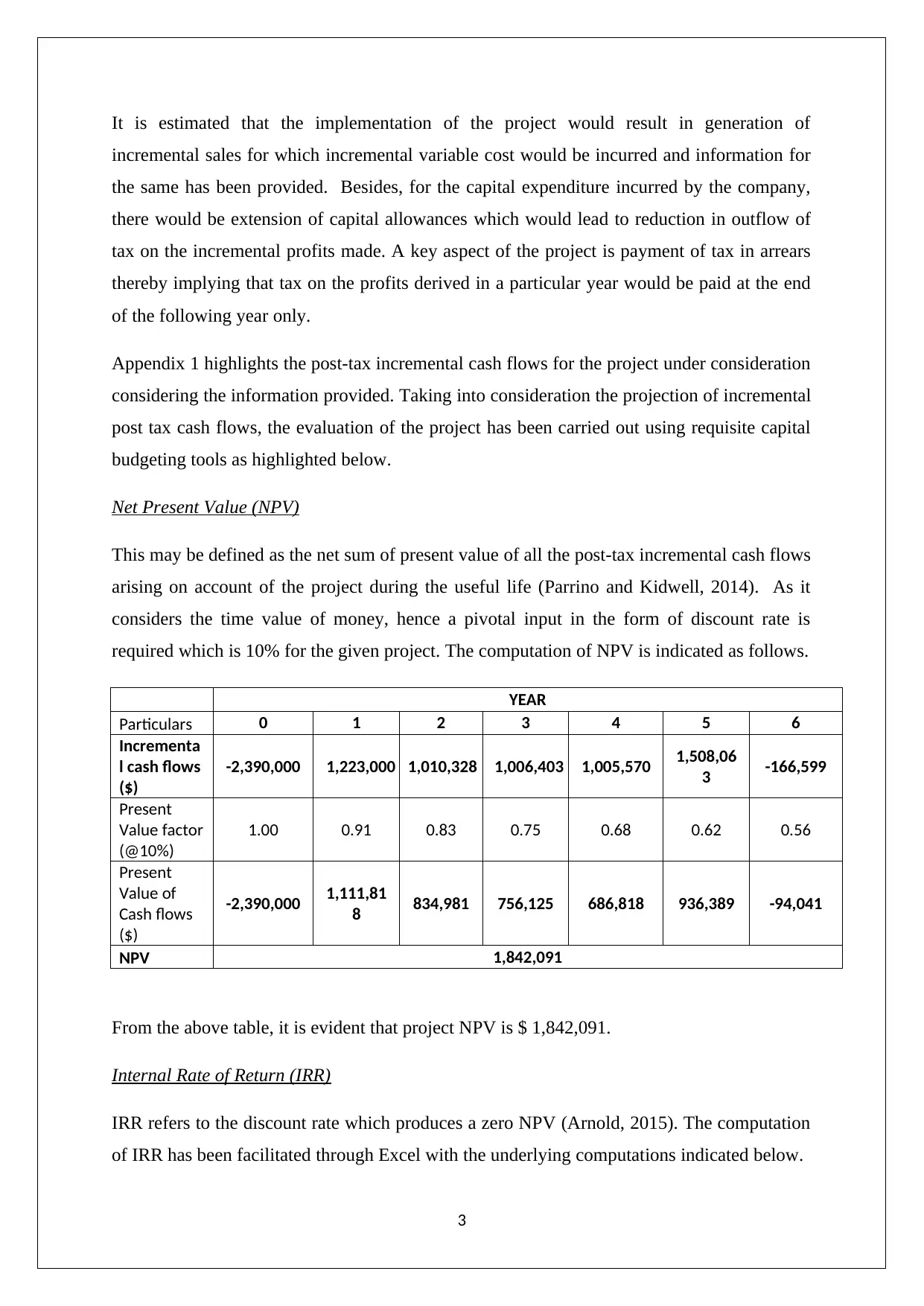
It is estimated that the implementation of the project would result in generation of
incremental sales for which incremental variable cost would be incurred and information for
the same has been provided. Besides, for the capital expenditure incurred by the company,
there would be extension of capital allowances which would lead to reduction in outflow of
tax on the incremental profits made. A key aspect of the project is payment of tax in arrears
thereby implying that tax on the profits derived in a particular year would be paid at the end
of the following year only.
Appendix 1 highlights the post-tax incremental cash flows for the project under consideration
considering the information provided. Taking into consideration the projection of incremental
post tax cash flows, the evaluation of the project has been carried out using requisite capital
budgeting tools as highlighted below.
Net Present Value (NPV)
This may be defined as the net sum of present value of all the post-tax incremental cash flows
arising on account of the project during the useful life (Parrino and Kidwell, 2014). As it
considers the time value of money, hence a pivotal input in the form of discount rate is
required which is 10% for the given project. The computation of NPV is indicated as follows.
YEAR
Particulars 0 1 2 3 4 5 6
Incrementa
l cash flows
($)
-2,390,000 1,223,000 1,010,328 1,006,403 1,005,570 1,508,06
3 -166,599
Present
Value factor
(@10%)
1.00 0.91 0.83 0.75 0.68 0.62 0.56
Present
Value of
Cash flows
($)
-2,390,000 1,111,81
8 834,981 756,125 686,818 936,389 -94,041
NPV 1,842,091
From the above table, it is evident that project NPV is $ 1,842,091.
Internal Rate of Return (IRR)
IRR refers to the discount rate which produces a zero NPV (Arnold, 2015). The computation
of IRR has been facilitated through Excel with the underlying computations indicated below.
3
incremental sales for which incremental variable cost would be incurred and information for
the same has been provided. Besides, for the capital expenditure incurred by the company,
there would be extension of capital allowances which would lead to reduction in outflow of
tax on the incremental profits made. A key aspect of the project is payment of tax in arrears
thereby implying that tax on the profits derived in a particular year would be paid at the end
of the following year only.
Appendix 1 highlights the post-tax incremental cash flows for the project under consideration
considering the information provided. Taking into consideration the projection of incremental
post tax cash flows, the evaluation of the project has been carried out using requisite capital
budgeting tools as highlighted below.
Net Present Value (NPV)
This may be defined as the net sum of present value of all the post-tax incremental cash flows
arising on account of the project during the useful life (Parrino and Kidwell, 2014). As it
considers the time value of money, hence a pivotal input in the form of discount rate is
required which is 10% for the given project. The computation of NPV is indicated as follows.
YEAR
Particulars 0 1 2 3 4 5 6
Incrementa
l cash flows
($)
-2,390,000 1,223,000 1,010,328 1,006,403 1,005,570 1,508,06
3 -166,599
Present
Value factor
(@10%)
1.00 0.91 0.83 0.75 0.68 0.62 0.56
Present
Value of
Cash flows
($)
-2,390,000 1,111,81
8 834,981 756,125 686,818 936,389 -94,041
NPV 1,842,091
From the above table, it is evident that project NPV is $ 1,842,091.
Internal Rate of Return (IRR)
IRR refers to the discount rate which produces a zero NPV (Arnold, 2015). The computation
of IRR has been facilitated through Excel with the underlying computations indicated below.
3
Paraphrase This Document
Need a fresh take? Get an instant paraphrase of this document with our AI Paraphraser
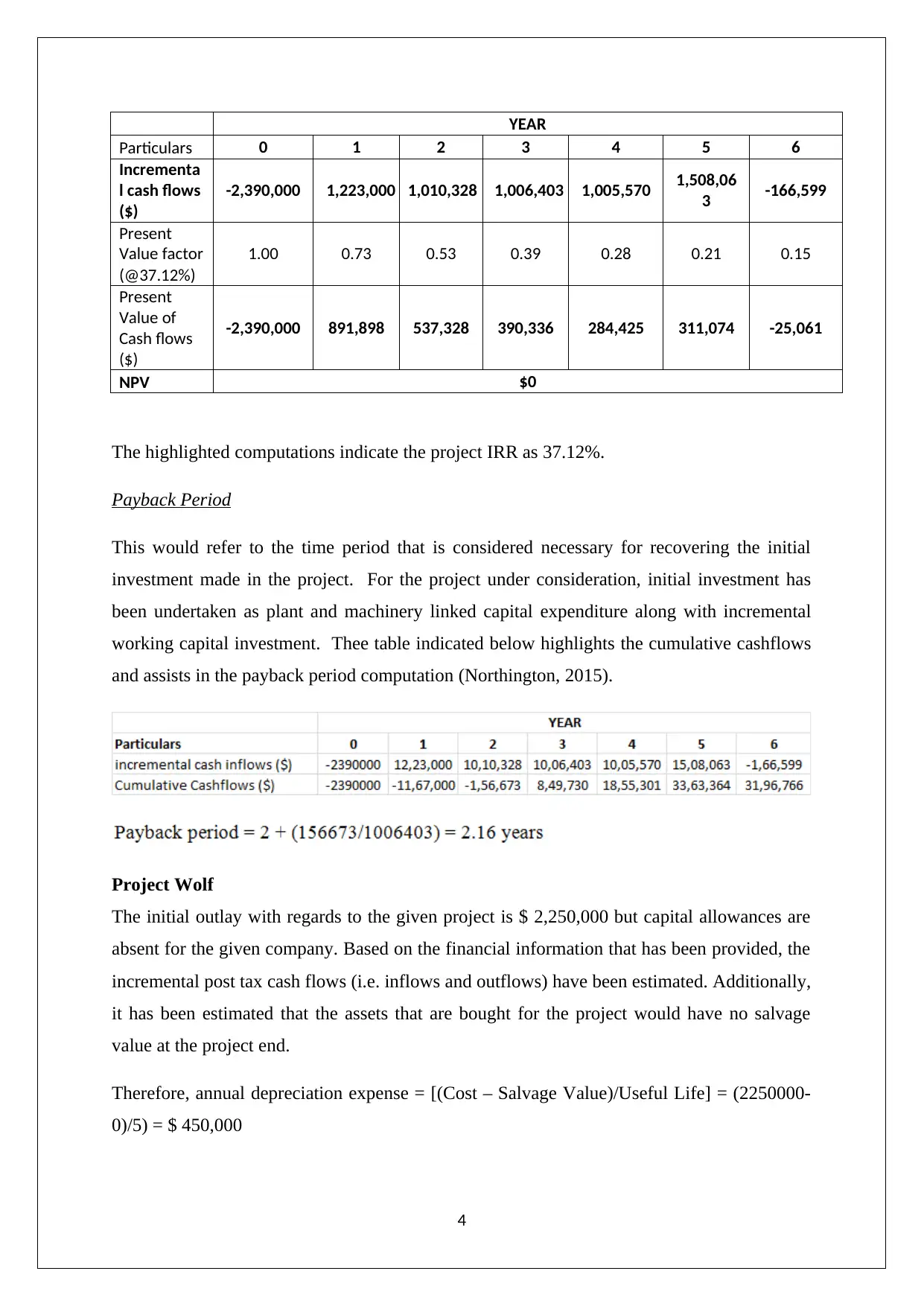
YEAR
Particulars 0 1 2 3 4 5 6
Incrementa
l cash flows
($)
-2,390,000 1,223,000 1,010,328 1,006,403 1,005,570 1,508,06
3 -166,599
Present
Value factor
(@37.12%)
1.00 0.73 0.53 0.39 0.28 0.21 0.15
Present
Value of
Cash flows
($)
-2,390,000 891,898 537,328 390,336 284,425 311,074 -25,061
NPV $0
The highlighted computations indicate the project IRR as 37.12%.
Payback Period
This would refer to the time period that is considered necessary for recovering the initial
investment made in the project. For the project under consideration, initial investment has
been undertaken as plant and machinery linked capital expenditure along with incremental
working capital investment. Thee table indicated below highlights the cumulative cashflows
and assists in the payback period computation (Northington, 2015).
Project Wolf
The initial outlay with regards to the given project is $ 2,250,000 but capital allowances are
absent for the given company. Based on the financial information that has been provided, the
incremental post tax cash flows (i.e. inflows and outflows) have been estimated. Additionally,
it has been estimated that the assets that are bought for the project would have no salvage
value at the project end.
Therefore, annual depreciation expense = [(Cost – Salvage Value)/Useful Life] = (2250000-
0)/5) = $ 450,000
4
Particulars 0 1 2 3 4 5 6
Incrementa
l cash flows
($)
-2,390,000 1,223,000 1,010,328 1,006,403 1,005,570 1,508,06
3 -166,599
Present
Value factor
(@37.12%)
1.00 0.73 0.53 0.39 0.28 0.21 0.15
Present
Value of
Cash flows
($)
-2,390,000 891,898 537,328 390,336 284,425 311,074 -25,061
NPV $0
The highlighted computations indicate the project IRR as 37.12%.
Payback Period
This would refer to the time period that is considered necessary for recovering the initial
investment made in the project. For the project under consideration, initial investment has
been undertaken as plant and machinery linked capital expenditure along with incremental
working capital investment. Thee table indicated below highlights the cumulative cashflows
and assists in the payback period computation (Northington, 2015).
Project Wolf
The initial outlay with regards to the given project is $ 2,250,000 but capital allowances are
absent for the given company. Based on the financial information that has been provided, the
incremental post tax cash flows (i.e. inflows and outflows) have been estimated. Additionally,
it has been estimated that the assets that are bought for the project would have no salvage
value at the project end.
Therefore, annual depreciation expense = [(Cost – Salvage Value)/Useful Life] = (2250000-
0)/5) = $ 450,000
4
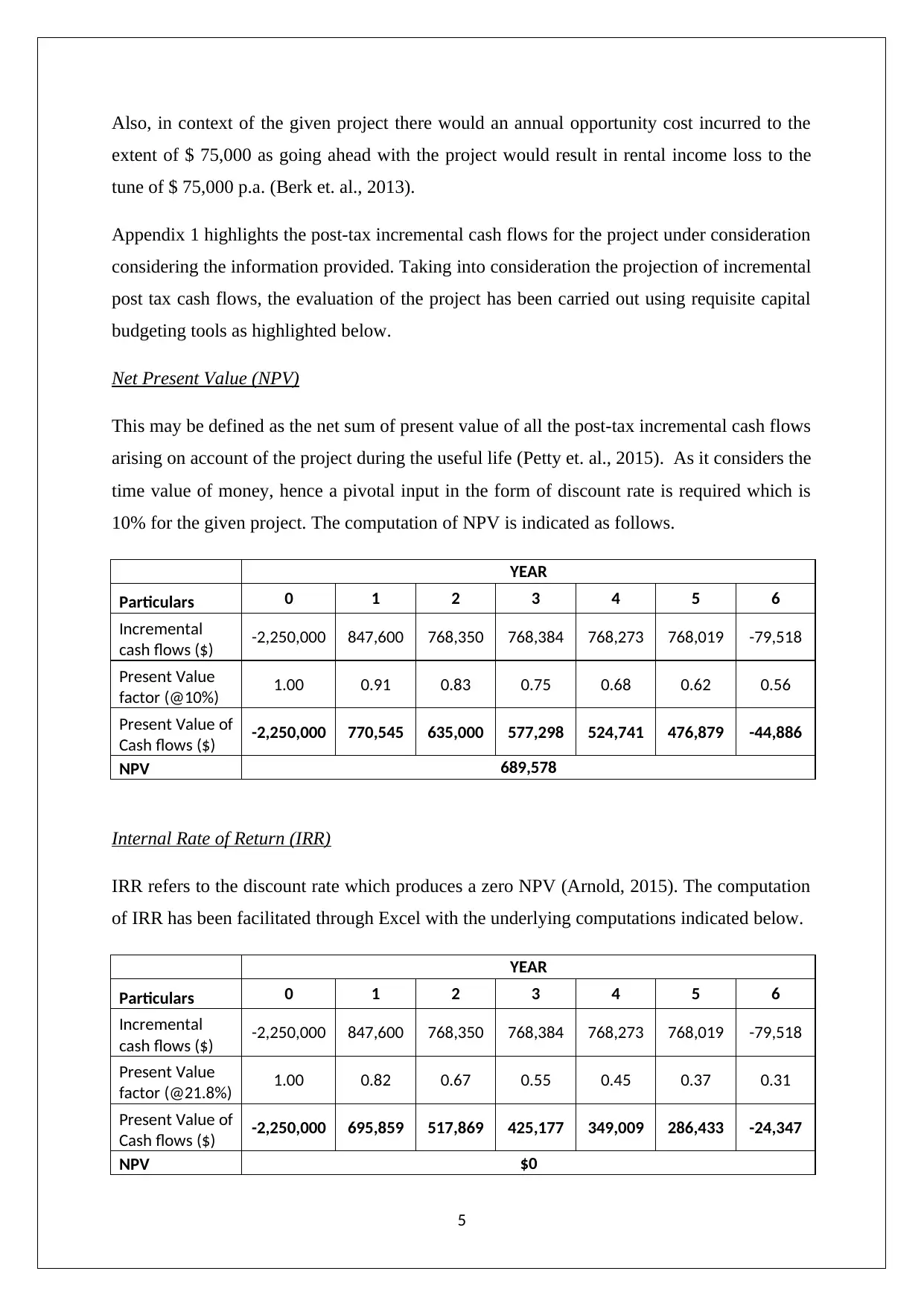
Also, in context of the given project there would an annual opportunity cost incurred to the
extent of $ 75,000 as going ahead with the project would result in rental income loss to the
tune of $ 75,000 p.a. (Berk et. al., 2013).
Appendix 1 highlights the post-tax incremental cash flows for the project under consideration
considering the information provided. Taking into consideration the projection of incremental
post tax cash flows, the evaluation of the project has been carried out using requisite capital
budgeting tools as highlighted below.
Net Present Value (NPV)
This may be defined as the net sum of present value of all the post-tax incremental cash flows
arising on account of the project during the useful life (Petty et. al., 2015). As it considers the
time value of money, hence a pivotal input in the form of discount rate is required which is
10% for the given project. The computation of NPV is indicated as follows.
YEAR
Particulars 0 1 2 3 4 5 6
Incremental
cash flows ($) -2,250,000 847,600 768,350 768,384 768,273 768,019 -79,518
Present Value
factor (@10%) 1.00 0.91 0.83 0.75 0.68 0.62 0.56
Present Value of
Cash flows ($) -2,250,000 770,545 635,000 577,298 524,741 476,879 -44,886
NPV 689,578
Internal Rate of Return (IRR)
IRR refers to the discount rate which produces a zero NPV (Arnold, 2015). The computation
of IRR has been facilitated through Excel with the underlying computations indicated below.
YEAR
Particulars 0 1 2 3 4 5 6
Incremental
cash flows ($) -2,250,000 847,600 768,350 768,384 768,273 768,019 -79,518
Present Value
factor (@21.8%) 1.00 0.82 0.67 0.55 0.45 0.37 0.31
Present Value of
Cash flows ($) -2,250,000 695,859 517,869 425,177 349,009 286,433 -24,347
NPV $0
5
extent of $ 75,000 as going ahead with the project would result in rental income loss to the
tune of $ 75,000 p.a. (Berk et. al., 2013).
Appendix 1 highlights the post-tax incremental cash flows for the project under consideration
considering the information provided. Taking into consideration the projection of incremental
post tax cash flows, the evaluation of the project has been carried out using requisite capital
budgeting tools as highlighted below.
Net Present Value (NPV)
This may be defined as the net sum of present value of all the post-tax incremental cash flows
arising on account of the project during the useful life (Petty et. al., 2015). As it considers the
time value of money, hence a pivotal input in the form of discount rate is required which is
10% for the given project. The computation of NPV is indicated as follows.
YEAR
Particulars 0 1 2 3 4 5 6
Incremental
cash flows ($) -2,250,000 847,600 768,350 768,384 768,273 768,019 -79,518
Present Value
factor (@10%) 1.00 0.91 0.83 0.75 0.68 0.62 0.56
Present Value of
Cash flows ($) -2,250,000 770,545 635,000 577,298 524,741 476,879 -44,886
NPV 689,578
Internal Rate of Return (IRR)
IRR refers to the discount rate which produces a zero NPV (Arnold, 2015). The computation
of IRR has been facilitated through Excel with the underlying computations indicated below.
YEAR
Particulars 0 1 2 3 4 5 6
Incremental
cash flows ($) -2,250,000 847,600 768,350 768,384 768,273 768,019 -79,518
Present Value
factor (@21.8%) 1.00 0.82 0.67 0.55 0.45 0.37 0.31
Present Value of
Cash flows ($) -2,250,000 695,859 517,869 425,177 349,009 286,433 -24,347
NPV $0
5
⊘ This is a preview!⊘
Do you want full access?
Subscribe today to unlock all pages.

Trusted by 1+ million students worldwide
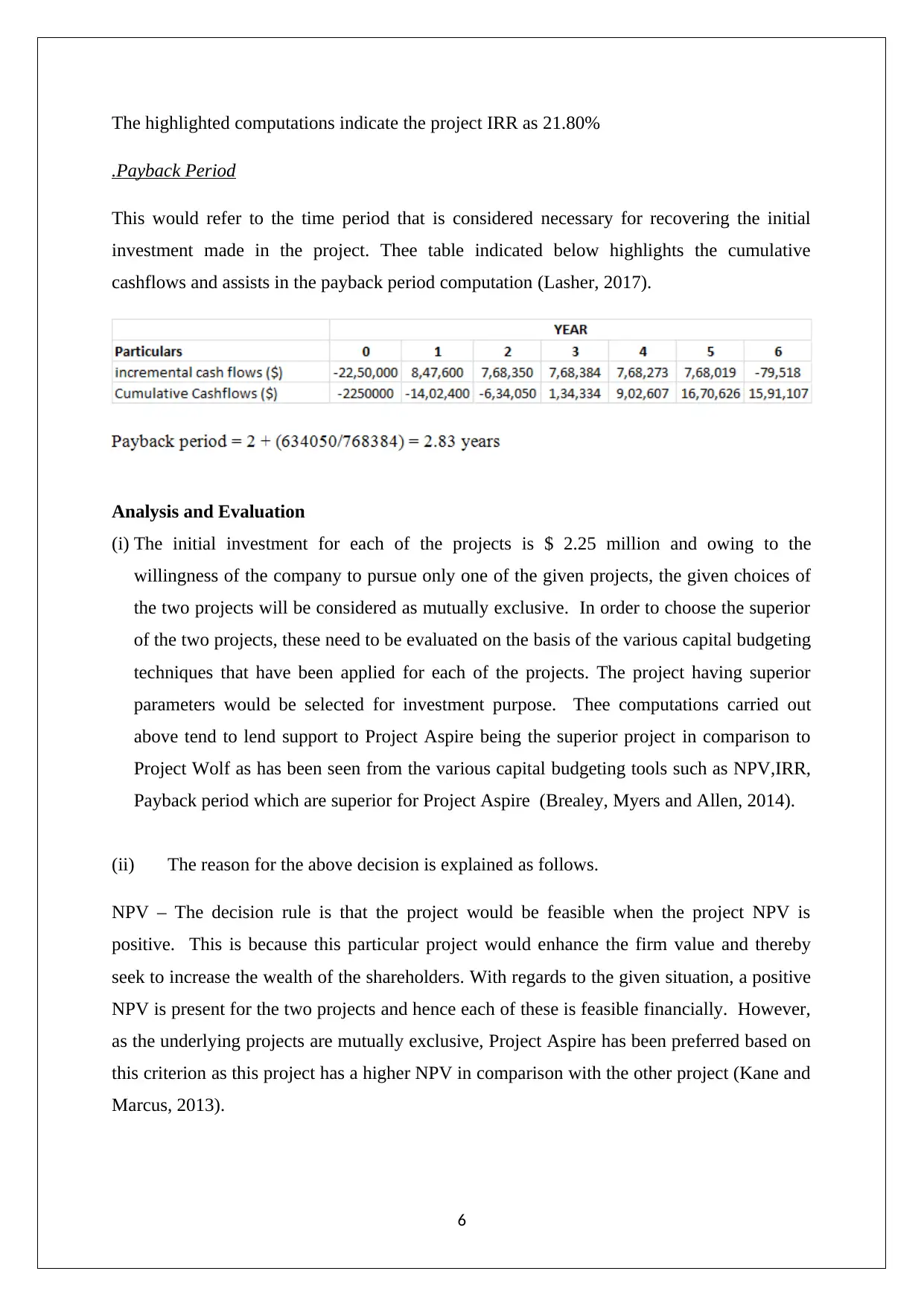
The highlighted computations indicate the project IRR as 21.80%
.Payback Period
This would refer to the time period that is considered necessary for recovering the initial
investment made in the project. Thee table indicated below highlights the cumulative
cashflows and assists in the payback period computation (Lasher, 2017).
Analysis and Evaluation
(i) The initial investment for each of the projects is $ 2.25 million and owing to the
willingness of the company to pursue only one of the given projects, the given choices of
the two projects will be considered as mutually exclusive. In order to choose the superior
of the two projects, these need to be evaluated on the basis of the various capital budgeting
techniques that have been applied for each of the projects. The project having superior
parameters would be selected for investment purpose. Thee computations carried out
above tend to lend support to Project Aspire being the superior project in comparison to
Project Wolf as has been seen from the various capital budgeting tools such as NPV,IRR,
Payback period which are superior for Project Aspire (Brealey, Myers and Allen, 2014).
(ii) The reason for the above decision is explained as follows.
NPV – The decision rule is that the project would be feasible when the project NPV is
positive. This is because this particular project would enhance the firm value and thereby
seek to increase the wealth of the shareholders. With regards to the given situation, a positive
NPV is present for the two projects and hence each of these is feasible financially. However,
as the underlying projects are mutually exclusive, Project Aspire has been preferred based on
this criterion as this project has a higher NPV in comparison with the other project (Kane and
Marcus, 2013).
6
.Payback Period
This would refer to the time period that is considered necessary for recovering the initial
investment made in the project. Thee table indicated below highlights the cumulative
cashflows and assists in the payback period computation (Lasher, 2017).
Analysis and Evaluation
(i) The initial investment for each of the projects is $ 2.25 million and owing to the
willingness of the company to pursue only one of the given projects, the given choices of
the two projects will be considered as mutually exclusive. In order to choose the superior
of the two projects, these need to be evaluated on the basis of the various capital budgeting
techniques that have been applied for each of the projects. The project having superior
parameters would be selected for investment purpose. Thee computations carried out
above tend to lend support to Project Aspire being the superior project in comparison to
Project Wolf as has been seen from the various capital budgeting tools such as NPV,IRR,
Payback period which are superior for Project Aspire (Brealey, Myers and Allen, 2014).
(ii) The reason for the above decision is explained as follows.
NPV – The decision rule is that the project would be feasible when the project NPV is
positive. This is because this particular project would enhance the firm value and thereby
seek to increase the wealth of the shareholders. With regards to the given situation, a positive
NPV is present for the two projects and hence each of these is feasible financially. However,
as the underlying projects are mutually exclusive, Project Aspire has been preferred based on
this criterion as this project has a higher NPV in comparison with the other project (Kane and
Marcus, 2013).
6
Paraphrase This Document
Need a fresh take? Get an instant paraphrase of this document with our AI Paraphraser
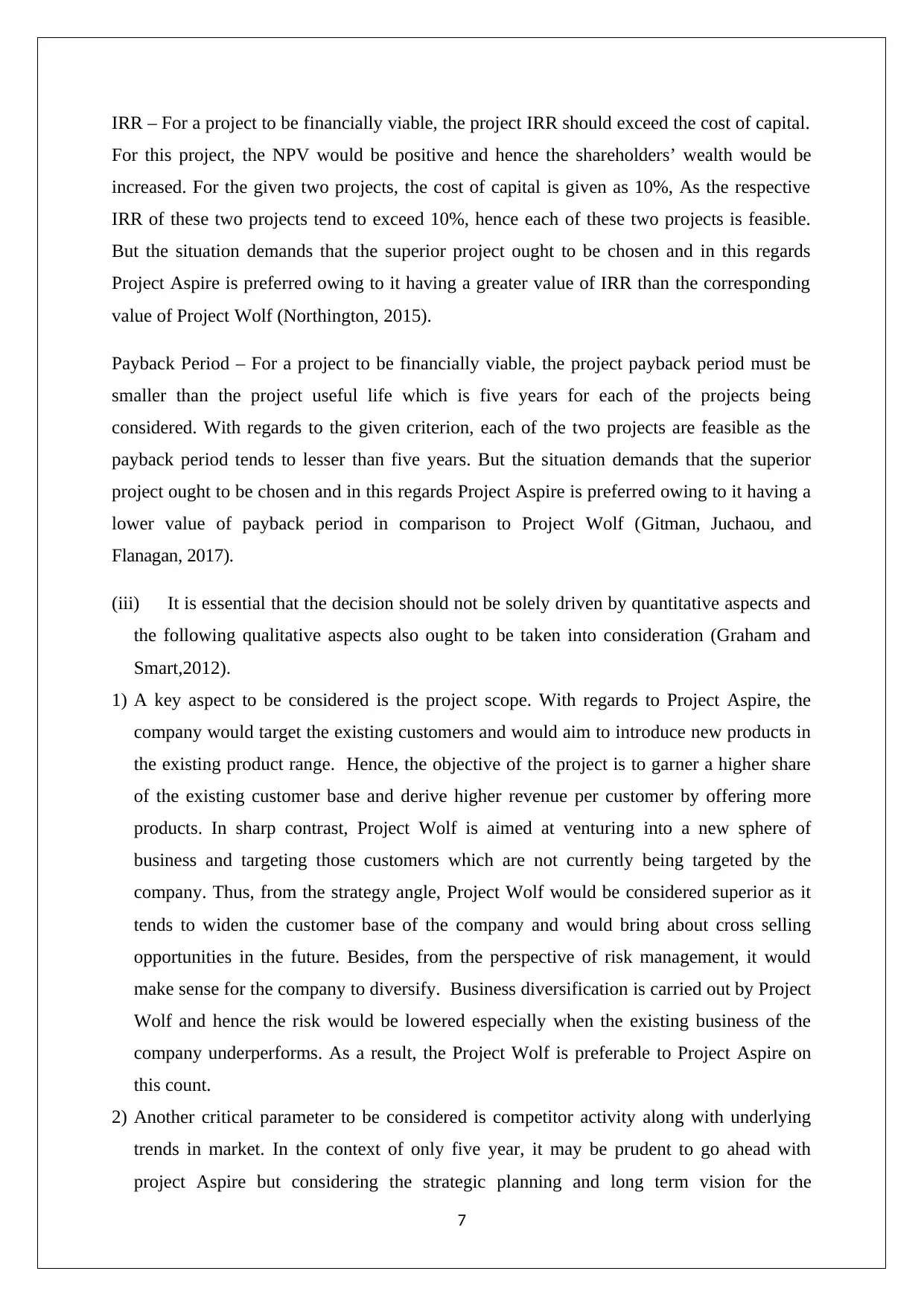
IRR – For a project to be financially viable, the project IRR should exceed the cost of capital.
For this project, the NPV would be positive and hence the shareholders’ wealth would be
increased. For the given two projects, the cost of capital is given as 10%, As the respective
IRR of these two projects tend to exceed 10%, hence each of these two projects is feasible.
But the situation demands that the superior project ought to be chosen and in this regards
Project Aspire is preferred owing to it having a greater value of IRR than the corresponding
value of Project Wolf (Northington, 2015).
Payback Period – For a project to be financially viable, the project payback period must be
smaller than the project useful life which is five years for each of the projects being
considered. With regards to the given criterion, each of the two projects are feasible as the
payback period tends to lesser than five years. But the situation demands that the superior
project ought to be chosen and in this regards Project Aspire is preferred owing to it having a
lower value of payback period in comparison to Project Wolf (Gitman, Juchaou, and
Flanagan, 2017).
(iii) It is essential that the decision should not be solely driven by quantitative aspects and
the following qualitative aspects also ought to be taken into consideration (Graham and
Smart,2012).
1) A key aspect to be considered is the project scope. With regards to Project Aspire, the
company would target the existing customers and would aim to introduce new products in
the existing product range. Hence, the objective of the project is to garner a higher share
of the existing customer base and derive higher revenue per customer by offering more
products. In sharp contrast, Project Wolf is aimed at venturing into a new sphere of
business and targeting those customers which are not currently being targeted by the
company. Thus, from the strategy angle, Project Wolf would be considered superior as it
tends to widen the customer base of the company and would bring about cross selling
opportunities in the future. Besides, from the perspective of risk management, it would
make sense for the company to diversify. Business diversification is carried out by Project
Wolf and hence the risk would be lowered especially when the existing business of the
company underperforms. As a result, the Project Wolf is preferable to Project Aspire on
this count.
2) Another critical parameter to be considered is competitor activity along with underlying
trends in market. In the context of only five year, it may be prudent to go ahead with
project Aspire but considering the strategic planning and long term vision for the
7
For this project, the NPV would be positive and hence the shareholders’ wealth would be
increased. For the given two projects, the cost of capital is given as 10%, As the respective
IRR of these two projects tend to exceed 10%, hence each of these two projects is feasible.
But the situation demands that the superior project ought to be chosen and in this regards
Project Aspire is preferred owing to it having a greater value of IRR than the corresponding
value of Project Wolf (Northington, 2015).
Payback Period – For a project to be financially viable, the project payback period must be
smaller than the project useful life which is five years for each of the projects being
considered. With regards to the given criterion, each of the two projects are feasible as the
payback period tends to lesser than five years. But the situation demands that the superior
project ought to be chosen and in this regards Project Aspire is preferred owing to it having a
lower value of payback period in comparison to Project Wolf (Gitman, Juchaou, and
Flanagan, 2017).
(iii) It is essential that the decision should not be solely driven by quantitative aspects and
the following qualitative aspects also ought to be taken into consideration (Graham and
Smart,2012).
1) A key aspect to be considered is the project scope. With regards to Project Aspire, the
company would target the existing customers and would aim to introduce new products in
the existing product range. Hence, the objective of the project is to garner a higher share
of the existing customer base and derive higher revenue per customer by offering more
products. In sharp contrast, Project Wolf is aimed at venturing into a new sphere of
business and targeting those customers which are not currently being targeted by the
company. Thus, from the strategy angle, Project Wolf would be considered superior as it
tends to widen the customer base of the company and would bring about cross selling
opportunities in the future. Besides, from the perspective of risk management, it would
make sense for the company to diversify. Business diversification is carried out by Project
Wolf and hence the risk would be lowered especially when the existing business of the
company underperforms. As a result, the Project Wolf is preferable to Project Aspire on
this count.
2) Another critical parameter to be considered is competitor activity along with underlying
trends in market. In the context of only five year, it may be prudent to go ahead with
project Aspire but considering the strategic planning and long term vision for the
7
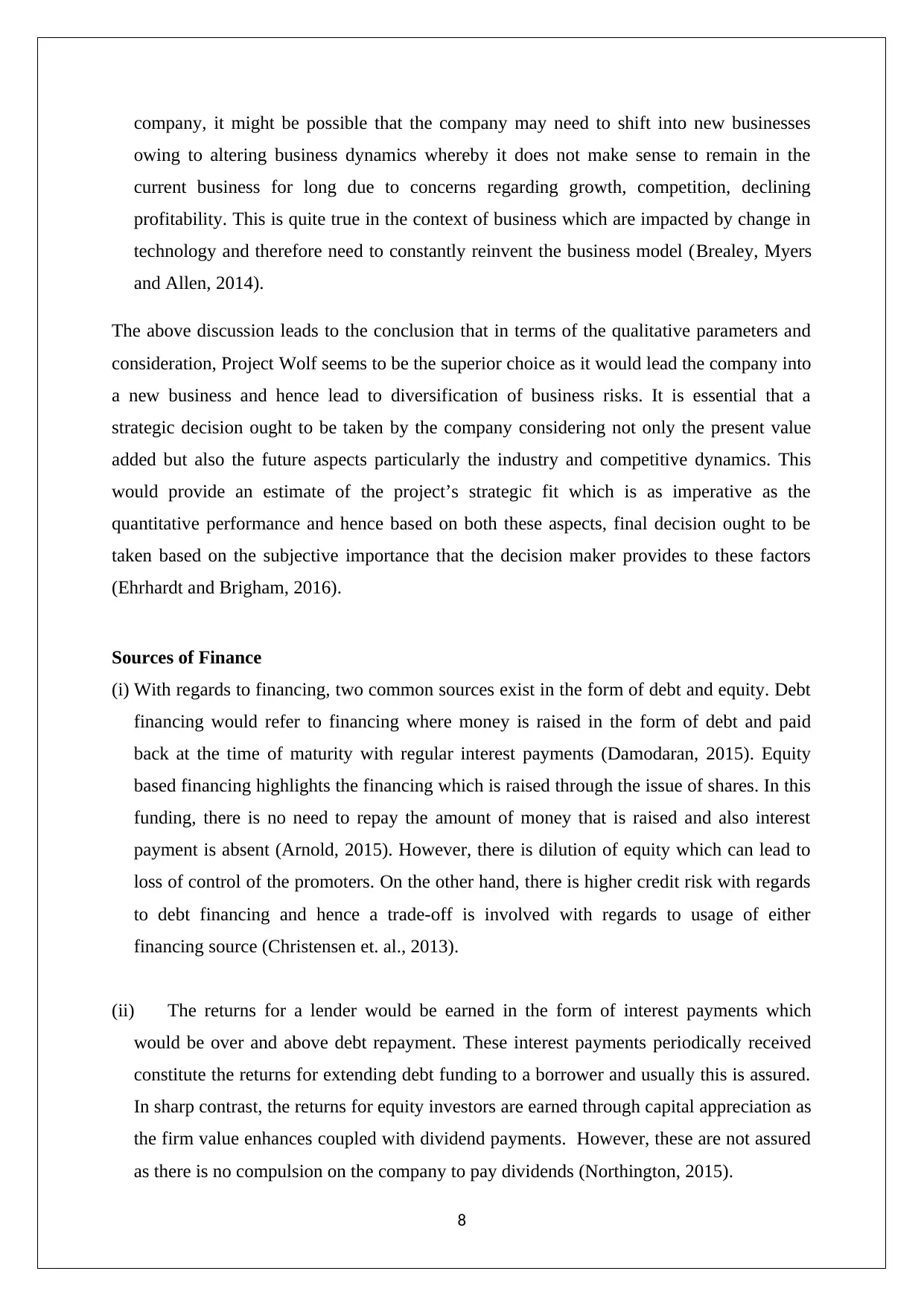
company, it might be possible that the company may need to shift into new businesses
owing to altering business dynamics whereby it does not make sense to remain in the
current business for long due to concerns regarding growth, competition, declining
profitability. This is quite true in the context of business which are impacted by change in
technology and therefore need to constantly reinvent the business model (Brealey, Myers
and Allen, 2014).
The above discussion leads to the conclusion that in terms of the qualitative parameters and
consideration, Project Wolf seems to be the superior choice as it would lead the company into
a new business and hence lead to diversification of business risks. It is essential that a
strategic decision ought to be taken by the company considering not only the present value
added but also the future aspects particularly the industry and competitive dynamics. This
would provide an estimate of the project’s strategic fit which is as imperative as the
quantitative performance and hence based on both these aspects, final decision ought to be
taken based on the subjective importance that the decision maker provides to these factors
(Ehrhardt and Brigham, 2016).
Sources of Finance
(i) With regards to financing, two common sources exist in the form of debt and equity. Debt
financing would refer to financing where money is raised in the form of debt and paid
back at the time of maturity with regular interest payments (Damodaran, 2015). Equity
based financing highlights the financing which is raised through the issue of shares. In this
funding, there is no need to repay the amount of money that is raised and also interest
payment is absent (Arnold, 2015). However, there is dilution of equity which can lead to
loss of control of the promoters. On the other hand, there is higher credit risk with regards
to debt financing and hence a trade-off is involved with regards to usage of either
financing source (Christensen et. al., 2013).
(ii) The returns for a lender would be earned in the form of interest payments which
would be over and above debt repayment. These interest payments periodically received
constitute the returns for extending debt funding to a borrower and usually this is assured.
In sharp contrast, the returns for equity investors are earned through capital appreciation as
the firm value enhances coupled with dividend payments. However, these are not assured
as there is no compulsion on the company to pay dividends (Northington, 2015).
8
owing to altering business dynamics whereby it does not make sense to remain in the
current business for long due to concerns regarding growth, competition, declining
profitability. This is quite true in the context of business which are impacted by change in
technology and therefore need to constantly reinvent the business model (Brealey, Myers
and Allen, 2014).
The above discussion leads to the conclusion that in terms of the qualitative parameters and
consideration, Project Wolf seems to be the superior choice as it would lead the company into
a new business and hence lead to diversification of business risks. It is essential that a
strategic decision ought to be taken by the company considering not only the present value
added but also the future aspects particularly the industry and competitive dynamics. This
would provide an estimate of the project’s strategic fit which is as imperative as the
quantitative performance and hence based on both these aspects, final decision ought to be
taken based on the subjective importance that the decision maker provides to these factors
(Ehrhardt and Brigham, 2016).
Sources of Finance
(i) With regards to financing, two common sources exist in the form of debt and equity. Debt
financing would refer to financing where money is raised in the form of debt and paid
back at the time of maturity with regular interest payments (Damodaran, 2015). Equity
based financing highlights the financing which is raised through the issue of shares. In this
funding, there is no need to repay the amount of money that is raised and also interest
payment is absent (Arnold, 2015). However, there is dilution of equity which can lead to
loss of control of the promoters. On the other hand, there is higher credit risk with regards
to debt financing and hence a trade-off is involved with regards to usage of either
financing source (Christensen et. al., 2013).
(ii) The returns for a lender would be earned in the form of interest payments which
would be over and above debt repayment. These interest payments periodically received
constitute the returns for extending debt funding to a borrower and usually this is assured.
In sharp contrast, the returns for equity investors are earned through capital appreciation as
the firm value enhances coupled with dividend payments. However, these are not assured
as there is no compulsion on the company to pay dividends (Northington, 2015).
8
⊘ This is a preview!⊘
Do you want full access?
Subscribe today to unlock all pages.

Trusted by 1+ million students worldwide
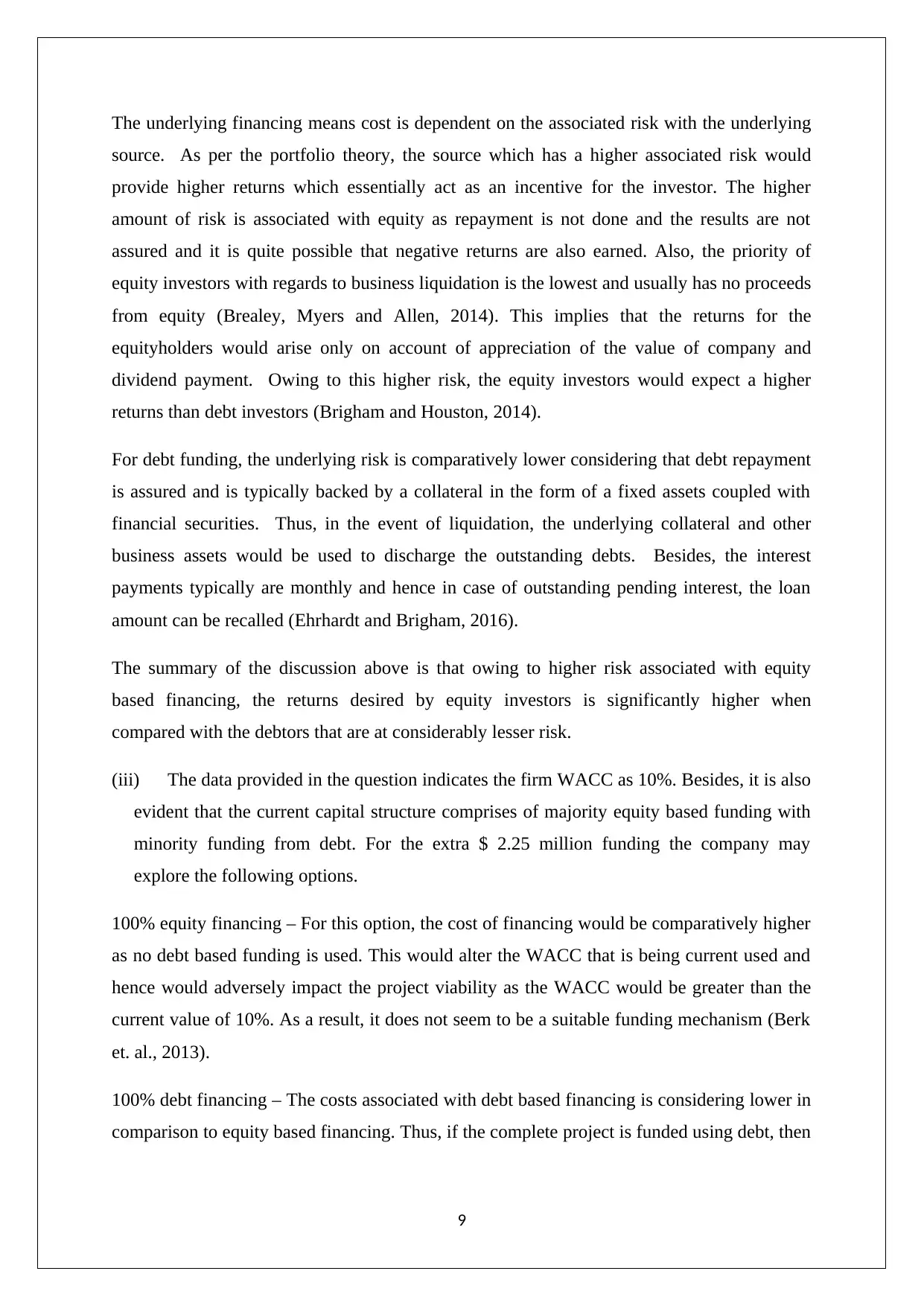
The underlying financing means cost is dependent on the associated risk with the underlying
source. As per the portfolio theory, the source which has a higher associated risk would
provide higher returns which essentially act as an incentive for the investor. The higher
amount of risk is associated with equity as repayment is not done and the results are not
assured and it is quite possible that negative returns are also earned. Also, the priority of
equity investors with regards to business liquidation is the lowest and usually has no proceeds
from equity (Brealey, Myers and Allen, 2014). This implies that the returns for the
equityholders would arise only on account of appreciation of the value of company and
dividend payment. Owing to this higher risk, the equity investors would expect a higher
returns than debt investors (Brigham and Houston, 2014).
For debt funding, the underlying risk is comparatively lower considering that debt repayment
is assured and is typically backed by a collateral in the form of a fixed assets coupled with
financial securities. Thus, in the event of liquidation, the underlying collateral and other
business assets would be used to discharge the outstanding debts. Besides, the interest
payments typically are monthly and hence in case of outstanding pending interest, the loan
amount can be recalled (Ehrhardt and Brigham, 2016).
The summary of the discussion above is that owing to higher risk associated with equity
based financing, the returns desired by equity investors is significantly higher when
compared with the debtors that are at considerably lesser risk.
(iii) The data provided in the question indicates the firm WACC as 10%. Besides, it is also
evident that the current capital structure comprises of majority equity based funding with
minority funding from debt. For the extra $ 2.25 million funding the company may
explore the following options.
100% equity financing – For this option, the cost of financing would be comparatively higher
as no debt based funding is used. This would alter the WACC that is being current used and
hence would adversely impact the project viability as the WACC would be greater than the
current value of 10%. As a result, it does not seem to be a suitable funding mechanism (Berk
et. al., 2013).
100% debt financing – The costs associated with debt based financing is considering lower in
comparison to equity based financing. Thus, if the complete project is funded using debt, then
9
source. As per the portfolio theory, the source which has a higher associated risk would
provide higher returns which essentially act as an incentive for the investor. The higher
amount of risk is associated with equity as repayment is not done and the results are not
assured and it is quite possible that negative returns are also earned. Also, the priority of
equity investors with regards to business liquidation is the lowest and usually has no proceeds
from equity (Brealey, Myers and Allen, 2014). This implies that the returns for the
equityholders would arise only on account of appreciation of the value of company and
dividend payment. Owing to this higher risk, the equity investors would expect a higher
returns than debt investors (Brigham and Houston, 2014).
For debt funding, the underlying risk is comparatively lower considering that debt repayment
is assured and is typically backed by a collateral in the form of a fixed assets coupled with
financial securities. Thus, in the event of liquidation, the underlying collateral and other
business assets would be used to discharge the outstanding debts. Besides, the interest
payments typically are monthly and hence in case of outstanding pending interest, the loan
amount can be recalled (Ehrhardt and Brigham, 2016).
The summary of the discussion above is that owing to higher risk associated with equity
based financing, the returns desired by equity investors is significantly higher when
compared with the debtors that are at considerably lesser risk.
(iii) The data provided in the question indicates the firm WACC as 10%. Besides, it is also
evident that the current capital structure comprises of majority equity based funding with
minority funding from debt. For the extra $ 2.25 million funding the company may
explore the following options.
100% equity financing – For this option, the cost of financing would be comparatively higher
as no debt based funding is used. This would alter the WACC that is being current used and
hence would adversely impact the project viability as the WACC would be greater than the
current value of 10%. As a result, it does not seem to be a suitable funding mechanism (Berk
et. al., 2013).
100% debt financing – The costs associated with debt based financing is considering lower in
comparison to equity based financing. Thus, if the complete project is funded using debt, then
9
Paraphrase This Document
Need a fresh take? Get an instant paraphrase of this document with our AI Paraphraser
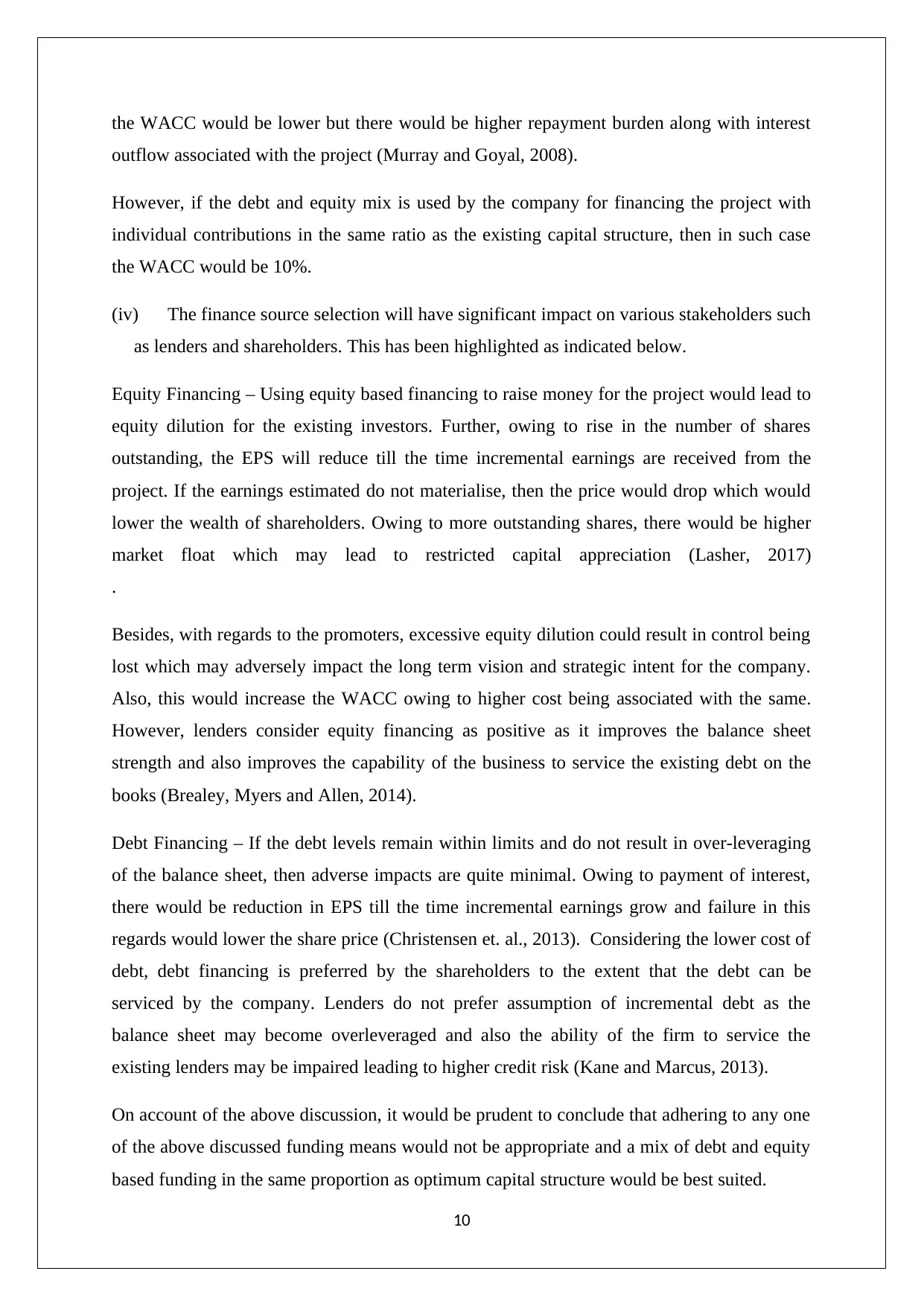
the WACC would be lower but there would be higher repayment burden along with interest
outflow associated with the project (Murray and Goyal, 2008).
However, if the debt and equity mix is used by the company for financing the project with
individual contributions in the same ratio as the existing capital structure, then in such case
the WACC would be 10%.
(iv) The finance source selection will have significant impact on various stakeholders such
as lenders and shareholders. This has been highlighted as indicated below.
Equity Financing – Using equity based financing to raise money for the project would lead to
equity dilution for the existing investors. Further, owing to rise in the number of shares
outstanding, the EPS will reduce till the time incremental earnings are received from the
project. If the earnings estimated do not materialise, then the price would drop which would
lower the wealth of shareholders. Owing to more outstanding shares, there would be higher
market float which may lead to restricted capital appreciation (Lasher, 2017)
.
Besides, with regards to the promoters, excessive equity dilution could result in control being
lost which may adversely impact the long term vision and strategic intent for the company.
Also, this would increase the WACC owing to higher cost being associated with the same.
However, lenders consider equity financing as positive as it improves the balance sheet
strength and also improves the capability of the business to service the existing debt on the
books (Brealey, Myers and Allen, 2014).
Debt Financing – If the debt levels remain within limits and do not result in over-leveraging
of the balance sheet, then adverse impacts are quite minimal. Owing to payment of interest,
there would be reduction in EPS till the time incremental earnings grow and failure in this
regards would lower the share price (Christensen et. al., 2013). Considering the lower cost of
debt, debt financing is preferred by the shareholders to the extent that the debt can be
serviced by the company. Lenders do not prefer assumption of incremental debt as the
balance sheet may become overleveraged and also the ability of the firm to service the
existing lenders may be impaired leading to higher credit risk (Kane and Marcus, 2013).
On account of the above discussion, it would be prudent to conclude that adhering to any one
of the above discussed funding means would not be appropriate and a mix of debt and equity
based funding in the same proportion as optimum capital structure would be best suited.
10
outflow associated with the project (Murray and Goyal, 2008).
However, if the debt and equity mix is used by the company for financing the project with
individual contributions in the same ratio as the existing capital structure, then in such case
the WACC would be 10%.
(iv) The finance source selection will have significant impact on various stakeholders such
as lenders and shareholders. This has been highlighted as indicated below.
Equity Financing – Using equity based financing to raise money for the project would lead to
equity dilution for the existing investors. Further, owing to rise in the number of shares
outstanding, the EPS will reduce till the time incremental earnings are received from the
project. If the earnings estimated do not materialise, then the price would drop which would
lower the wealth of shareholders. Owing to more outstanding shares, there would be higher
market float which may lead to restricted capital appreciation (Lasher, 2017)
.
Besides, with regards to the promoters, excessive equity dilution could result in control being
lost which may adversely impact the long term vision and strategic intent for the company.
Also, this would increase the WACC owing to higher cost being associated with the same.
However, lenders consider equity financing as positive as it improves the balance sheet
strength and also improves the capability of the business to service the existing debt on the
books (Brealey, Myers and Allen, 2014).
Debt Financing – If the debt levels remain within limits and do not result in over-leveraging
of the balance sheet, then adverse impacts are quite minimal. Owing to payment of interest,
there would be reduction in EPS till the time incremental earnings grow and failure in this
regards would lower the share price (Christensen et. al., 2013). Considering the lower cost of
debt, debt financing is preferred by the shareholders to the extent that the debt can be
serviced by the company. Lenders do not prefer assumption of incremental debt as the
balance sheet may become overleveraged and also the ability of the firm to service the
existing lenders may be impaired leading to higher credit risk (Kane and Marcus, 2013).
On account of the above discussion, it would be prudent to conclude that adhering to any one
of the above discussed funding means would not be appropriate and a mix of debt and equity
based funding in the same proportion as optimum capital structure would be best suited.
10
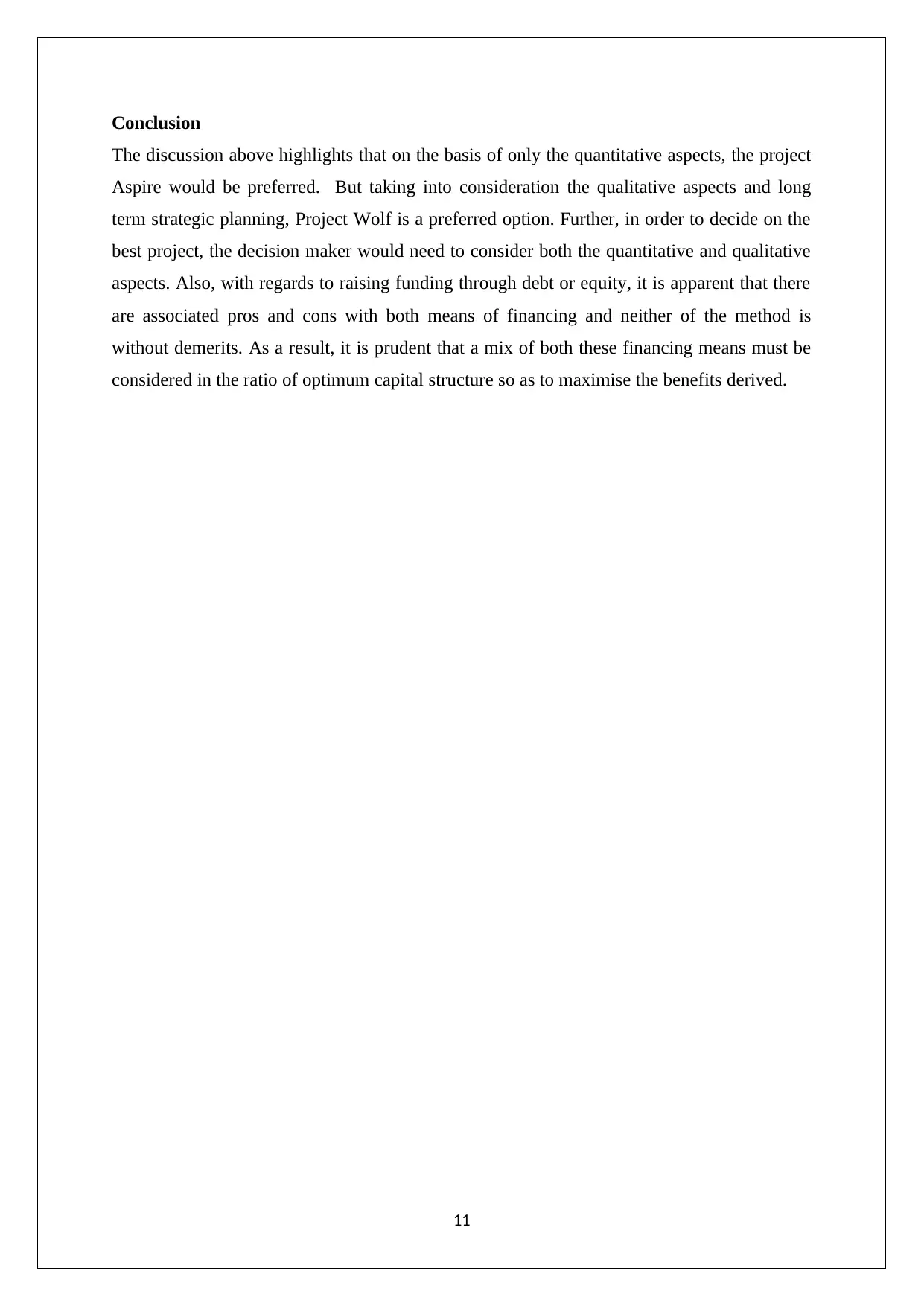
Conclusion
The discussion above highlights that on the basis of only the quantitative aspects, the project
Aspire would be preferred. But taking into consideration the qualitative aspects and long
term strategic planning, Project Wolf is a preferred option. Further, in order to decide on the
best project, the decision maker would need to consider both the quantitative and qualitative
aspects. Also, with regards to raising funding through debt or equity, it is apparent that there
are associated pros and cons with both means of financing and neither of the method is
without demerits. As a result, it is prudent that a mix of both these financing means must be
considered in the ratio of optimum capital structure so as to maximise the benefits derived.
11
The discussion above highlights that on the basis of only the quantitative aspects, the project
Aspire would be preferred. But taking into consideration the qualitative aspects and long
term strategic planning, Project Wolf is a preferred option. Further, in order to decide on the
best project, the decision maker would need to consider both the quantitative and qualitative
aspects. Also, with regards to raising funding through debt or equity, it is apparent that there
are associated pros and cons with both means of financing and neither of the method is
without demerits. As a result, it is prudent that a mix of both these financing means must be
considered in the ratio of optimum capital structure so as to maximise the benefits derived.
11
⊘ This is a preview!⊘
Do you want full access?
Subscribe today to unlock all pages.

Trusted by 1+ million students worldwide
1 out of 15
Related Documents
Your All-in-One AI-Powered Toolkit for Academic Success.
+13062052269
info@desklib.com
Available 24*7 on WhatsApp / Email
![[object Object]](/_next/static/media/star-bottom.7253800d.svg)
Unlock your academic potential
Copyright © 2020–2025 A2Z Services. All Rights Reserved. Developed and managed by ZUCOL.





